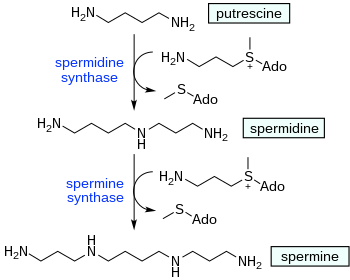Contents
Spermine is a polyamine involved in cellular metabolism that is found in all eukaryotic cells. The precursor for synthesis of spermine is the amino acid ornithine. It is an essential growth factor in some bacteria as well. It is found as a polycation at physiological pH. Spermine is associated with nucleic acids and is thought to stabilize helical structure, particularly in viruses. It functions as an intracellular free radical scavenger to protect DNA from free radical attack.[1] Spermine is the chemical primarily responsible for the characteristic odor of semen.[2]
Antonie van Leeuwenhoek first described crystals of spermine phosphate in human semen in 1678.[3] The name spermin was first used by the German chemists Ladenburg and Abel in 1888,[4][5] and the correct structure of spermine was not finally established until 1926, simultaneously in England (by Dudley, Rosenheim, and Starling)[6][7] and Germany (by Wrede et al.).[8]
Derivative
A derivative of spermine, N1, N12-bis(ethyl)spermine (also known as BESm) was investigated in the late 1980s along with similar polyamine analogues for its potential as a cancer therapy.[9][10]
Biosynthesis

Spermine biosynthesis in animals starts with decarboxylation of ornithine by the enzyme Ornithine decarboxylase in the presence of PLP. This decarboxylation gives putrescine. Thereafter the enzyme spermidine synthase effects two N-alkylation by decarboxy-S-adenosyl methionine. The intermediate is spermidine.
Plants employ additional routes to spermine. In one pathway L-glutamine is the precursor to L-ornithine, after which the synthesis of spermine from L-ornithine follows the same pathway as in animals.
Another pathway in plants starts with decarboxylation of L-arginine to produce agmatine. The imine functional group in agmatine then is hydrolysed by agmatine deiminase, releasing ammonia, converting the guanidine group into a urea. The resulting N-carbamoylputrescine is acted on by a hydrolase to split off the urea group, leaving putrescine. After that the putrescine follows the same pathway to completing the synthesis of spermine.[11]
References
- ^ Ha, Hyo Chol; Sirisoma, Nilantha S.; Kuppusamy, Periannan; Zweier, Jay L.; Woster, Patrick M.; Casero, Robert A. (1998-09-15). "The natural polyamine spermine functions directly as a free radical scavenger". PNAS. 95 (19): 11140–11145. doi:10.1073/pnas.95.19.11140. ISSN 0027-8424. PMC 21609. PMID 9736703.
- ^ Klein, David (2013). Organic Chemistry (2nd ed.).
- ^ Lewenhoeck, D. A (1677). "Observationes D. Anthonii Lewenhoeck, De Natis E Semine Genitali Animalculis". Philosophical Transactions of the Royal Society of London. 12 (133–142): 1040–1046. Bibcode:1677RSPT...12.1040A. doi:10.1098/rstl.1677.0068.
- ^ Ladenburg, A; Abel, J (1888). "Ueber das Aethylenimin (Spermin?)". Berichte der Deutschen Chemischen Gesellschaft. 21: 758–766. doi:10.1002/cber.188802101139.
- ^ Ladenburg, A; Abel, J (1888). "Nachtrag zu der Mittheilung über das Aethylenimin". Berichte der Deutschen Chemischen Gesellschaft. 21 (2): 2706. doi:10.1002/cber.18880210293.
- ^ Dudley, H. W; Rosenheim, O; Starling, W. W (1926). "The Chemical Constitution of Spermine: Structure and Synthesis". Biochemical Journal. 20 (5): 1082–1094. doi:10.1042/bj0201082. PMC 1251823. PMID 16743746.
- ^ Dudley, Harold Ward; Rosenheim, Mary Christine; Rosenheim, Otto (1924). "The Chemical Constitution of Spermine. I. The Isolation of Spermine from Animal Tissues, and the Preparation of its Salts". Biochemical Journal. 18 (6): 1263–72. doi:10.1042/bj0181263. PMC 1259516. PMID 16743399.
- ^ Wrede, F (2009). "Ueber die aus dem menschlichen Sperma isolierte Base Spermin". Deutsche Medizinische Wochenschrift. 51: 24. doi:10.1055/s-0028-1136345.
- ^ Porter, Carl W.; McManis, Jim; Casero, Robert A.; Bergeron, Raymond J. (1987). "Relative Abilities of Bis(ethyl) Derivatives of Putrescine, Spermidine, and Spermine to Regulate Polyamine Biosynthesis and Inhibit L1210 Leukemia Cell Growth" (PDF). Cancer Research. 47 (11): 2821–5. PMID 3567905.
- ^ Pegg, Anthony E.; Wechter, Rita; Pakala, Rajbabu; Bergeron, Raymond J. (1989). "Effect of N1, N12-Bis(ethyl)spermine and Related Compounds on Growth and Polyamine Acetylation, Content, and Excretion in Human Colon Tumor Cells" (PDF). Journal of Biological Chemistry. 264 (20): 11744–11749. doi:10.1016/S0021-9258(18)80128-4. PMID 2745415.
- ^ Dewick, Paul M (2009). Medicinal Natural Products: a biosynthetic approach (3rd ed.). Chichester U.K.: Wiley. p. 312. ISBN 9780470742761.

